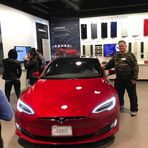Flames and Futures: The Turbulent Landscape of Autonomous Vehicles Amidst Political Unrest
June 11, 2025, 10:29 pm

Location: United States, Kansas, Winfield
Employees: 1001-5000
Founded date: 2011
Total raised: $820K

Location: United States, California, Mountain View
Employees: 1001-5000
Founded date: 2009
Total raised: $19.17B

Location: United States, Texas, Austin
Employees: 10001+
Founded date: 2003
Total raised: $3.86B
In the heart of Los Angeles, a new chapter in the saga of autonomous vehicles unfolded. Waymo’s robotaxis, symbols of technological advancement, became targets of protest. As flames engulfed these vehicles, the streets echoed with the cries of demonstrators against the Trump administration’s immigration policies. This incident was not just a flashpoint; it was a stark reminder of the intersection between technology, politics, and public sentiment.
Waymo, a subsidiary of Alphabet, had been expanding its robotaxi service across Los Angeles. The company had invested heavily in its fleet, boasting over 1,500 vehicles. But on that fateful day, the shiny exteriors of these autonomous cars were marred by graffiti and fire. Protesters, fueled by anger over recent Immigration and Customs Enforcement (ICE) raids, targeted the vehicles, viewing them as symbols of a system they opposed. The images of burning robotaxis, with anti-ICE slogans painted across their hoods, captured the chaos of the moment.
The protests erupted following a series of ICE raids that left many communities shaken. While the demonstrations began peacefully, tensions escalated. Police clashed with protesters, and the California National Guard was deployed. Governor Gavin Newsom announced plans to sue the Trump administration, igniting a political firestorm. The situation was volatile, and Waymo had no choice but to suspend its services in the affected areas, prioritizing safety over operations.
Meanwhile, in Austin, Texas, a different narrative was unfolding. Tesla, another giant in the autonomous vehicle space, was preparing to launch its own robotaxi service. Elon Musk, the company’s CEO, shared a video showcasing driverless vehicles navigating the streets. This was a bold step, signaling Tesla’s commitment to the future of transportation. The stock market responded positively, with Tesla shares rallying after a tumultuous week marked by Musk’s public feud with Trump.
Musk’s spat with the former president had sent shockwaves through the market, causing Tesla’s stock to plummet. Investors were anxious, fearing the fallout from Musk’s political engagements. However, the tide turned as Musk showcased Tesla’s advancements in autonomous technology. The video of a Model Y navigating Austin’s streets without a human driver was a glimpse into the future. It was a moment of hope amidst uncertainty.
The contrast between Waymo’s fiery protests and Tesla’s technological triumphs highlights the complex landscape of autonomous vehicles. On one hand, you have Waymo, facing backlash and vandalism in a politically charged environment. On the other, Tesla is pushing forward, despite the noise surrounding Musk’s political antics. The two companies are at different crossroads, yet both are navigating the same turbulent waters of public perception and regulatory scrutiny.
As Waymo grapples with the aftermath of the protests, it faces questions about its role in the community. Are these vehicles merely tools of convenience, or do they represent a larger system that some seek to dismantle? The vandalism of Waymo’s fleet raises critical issues about the societal implications of autonomous technology. It forces us to consider who benefits from these advancements and at what cost.
In contrast, Tesla’s approach seems more aggressive. Musk’s vision for a driverless future is ambitious, but it’s not without risks. The rollout of Tesla’s robotaxi service will be limited initially, with a small fleet geofenced to ensure safety. Yet, the promise of unsupervised driving raises eyebrows. How safe are these vehicles? Can they navigate the complexities of urban environments without human intervention? Experts caution against getting too excited. The technology is still in its infancy, and the road ahead is fraught with challenges.
The juxtaposition of these two narratives—Waymo’s struggle against political unrest and Tesla’s bold strides into the future—underscores the unpredictability of the autonomous vehicle market. Investors are watching closely. The stakes are high, and the landscape is shifting rapidly. As Waymo reassesses its strategy in the wake of the protests, Tesla is poised to capitalize on its technological advancements.
The future of autonomous vehicles is not just about technology; it’s about societal acceptance. As protests against immigration policies highlight deep-seated issues, companies like Waymo and Tesla must navigate these waters carefully. They are not just selling rides; they are part of a larger conversation about ethics, community, and progress.
In the coming months, we will see how these companies adapt. Will Waymo find a way to rebuild trust in the communities it serves? Can Tesla maintain its momentum amidst the challenges posed by competition and regulatory scrutiny? The answers remain uncertain, but one thing is clear: the road ahead will be anything but smooth.
As we watch this unfolding drama, we are reminded that technology does not exist in a vacuum. It is intertwined with the fabric of society. The flames that consumed Waymo’s vehicles serve as a stark reminder of the challenges that lie ahead. The future of autonomous vehicles is bright, but it is also fraught with complexities that demand our attention. The journey is just beginning, and the destination remains to be seen.
Waymo, a subsidiary of Alphabet, had been expanding its robotaxi service across Los Angeles. The company had invested heavily in its fleet, boasting over 1,500 vehicles. But on that fateful day, the shiny exteriors of these autonomous cars were marred by graffiti and fire. Protesters, fueled by anger over recent Immigration and Customs Enforcement (ICE) raids, targeted the vehicles, viewing them as symbols of a system they opposed. The images of burning robotaxis, with anti-ICE slogans painted across their hoods, captured the chaos of the moment.
The protests erupted following a series of ICE raids that left many communities shaken. While the demonstrations began peacefully, tensions escalated. Police clashed with protesters, and the California National Guard was deployed. Governor Gavin Newsom announced plans to sue the Trump administration, igniting a political firestorm. The situation was volatile, and Waymo had no choice but to suspend its services in the affected areas, prioritizing safety over operations.
Meanwhile, in Austin, Texas, a different narrative was unfolding. Tesla, another giant in the autonomous vehicle space, was preparing to launch its own robotaxi service. Elon Musk, the company’s CEO, shared a video showcasing driverless vehicles navigating the streets. This was a bold step, signaling Tesla’s commitment to the future of transportation. The stock market responded positively, with Tesla shares rallying after a tumultuous week marked by Musk’s public feud with Trump.
Musk’s spat with the former president had sent shockwaves through the market, causing Tesla’s stock to plummet. Investors were anxious, fearing the fallout from Musk’s political engagements. However, the tide turned as Musk showcased Tesla’s advancements in autonomous technology. The video of a Model Y navigating Austin’s streets without a human driver was a glimpse into the future. It was a moment of hope amidst uncertainty.
The contrast between Waymo’s fiery protests and Tesla’s technological triumphs highlights the complex landscape of autonomous vehicles. On one hand, you have Waymo, facing backlash and vandalism in a politically charged environment. On the other, Tesla is pushing forward, despite the noise surrounding Musk’s political antics. The two companies are at different crossroads, yet both are navigating the same turbulent waters of public perception and regulatory scrutiny.
As Waymo grapples with the aftermath of the protests, it faces questions about its role in the community. Are these vehicles merely tools of convenience, or do they represent a larger system that some seek to dismantle? The vandalism of Waymo’s fleet raises critical issues about the societal implications of autonomous technology. It forces us to consider who benefits from these advancements and at what cost.
In contrast, Tesla’s approach seems more aggressive. Musk’s vision for a driverless future is ambitious, but it’s not without risks. The rollout of Tesla’s robotaxi service will be limited initially, with a small fleet geofenced to ensure safety. Yet, the promise of unsupervised driving raises eyebrows. How safe are these vehicles? Can they navigate the complexities of urban environments without human intervention? Experts caution against getting too excited. The technology is still in its infancy, and the road ahead is fraught with challenges.
The juxtaposition of these two narratives—Waymo’s struggle against political unrest and Tesla’s bold strides into the future—underscores the unpredictability of the autonomous vehicle market. Investors are watching closely. The stakes are high, and the landscape is shifting rapidly. As Waymo reassesses its strategy in the wake of the protests, Tesla is poised to capitalize on its technological advancements.
The future of autonomous vehicles is not just about technology; it’s about societal acceptance. As protests against immigration policies highlight deep-seated issues, companies like Waymo and Tesla must navigate these waters carefully. They are not just selling rides; they are part of a larger conversation about ethics, community, and progress.
In the coming months, we will see how these companies adapt. Will Waymo find a way to rebuild trust in the communities it serves? Can Tesla maintain its momentum amidst the challenges posed by competition and regulatory scrutiny? The answers remain uncertain, but one thing is clear: the road ahead will be anything but smooth.
As we watch this unfolding drama, we are reminded that technology does not exist in a vacuum. It is intertwined with the fabric of society. The flames that consumed Waymo’s vehicles serve as a stark reminder of the challenges that lie ahead. The future of autonomous vehicles is bright, but it is also fraught with complexities that demand our attention. The journey is just beginning, and the destination remains to be seen.